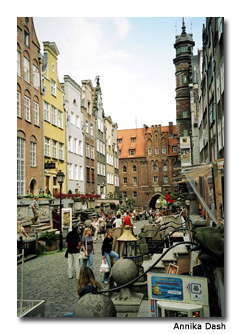
 Gliding on kayaks down the Motlawa River beside a waterfront of colorful buildings offers a stunning first view of the northern Polish city Gdansk. Crowds walk up and down the promenade stopping to watch buskers along the way. Vines grow over balconies of fancy restaurants where waiters wear sailor attire.
Gliding on kayaks down the Motlawa River beside a waterfront of colorful buildings offers a stunning first view of the northern Polish city Gdansk. Crowds walk up and down the promenade stopping to watch buskers along the way. Vines grow over balconies of fancy restaurants where waiters wear sailor attire.
Gdansk, formerly known as Danzig, is part of the Tri-City area, which includes Gdynia and Sopot. The city is filled with history, young and old. It was the birthplace of the Solidarity movement, which led to the breakdown of communism in Poland.
The entire city was obliterated during World War II when Soviet and German forces fought here and it had to be painstakingly rebuilt. When wandering through the town it is hard to believe the houses, churches and cobbled streets aren’t originals. The main square is delightful.
The buildings are all different bright colors with intricate facades. In the center of the square stands a bronze statue of the sea god Neptune, the patron of Gdansk.

This statue is the original. During the war it was dismantled and hidden along with other treasures until it was returned to its rightful place in 1954. The statue, erected in 1549, was converted to a fountain in 1633.
Gdansk is full of lovely streets but one of the prettiest is Mariacki Street, which is long and full of amber traders and craft shops. The elegant buildings are plainer than in the square. The balcony rails are delicate and the windowsills are filled with blooming flowerpots.
At the end of the street towers St. Mary’s church. It is red brick with light green spires and large, plain stained-glass windows. It is said to be the biggest brick church in the world. Inside the church are massive high white ceilings. A 46-foot (14 m) crucifix hangs from the ceiling but from below it looks tiny compared to the rest of the building.
The church also houses an enormous 46-foot (14 m) astronomical clock, which was built in 1464. The complex dial shows the date, phases of the moon and the position of the sun and moon in relation to Zodiac signs. One legend says that the clock was considered so beautiful that the king ordered the clockmaker’s eyes to be gouged out so he could never make another clock to rival this one.
We climb the 256-foot (78 m) tower of the church, which consists of 405 steps. The view is stunning and we can see as far as the long coastline that stretches along Sopot and Gdynia. We can also see the gloomy, industrial former Lenin shipyards, which were made famous worldwide in the 1980s when the workers, led by Lech Walesa, went on strike and formed the Solidarity movement.
A huge steel sculpture dedicated to the forerunners of Solidarity stands right outside the gate to the shipyard. In 1970, 45 shipyard workers died at the army’s hand while protesting conditions under communist rule.
Behind this sculpture is the “Roads to Freedom” exhibition, a museum dedicated to Solidarity. The first thing you notice upon entering is an exhibit of a grocery store during communist times. There is virtually no produce on the shelves, just a smattering of cheese, milk and other essential items. The ration cards, which people needed to line up with to be served, are also displayed.

Listed on the walls inside are the 21 demands made by the shipyard workers and other workers from all over Poland who fought for Solidarity, or unity. There is footage of Lech Walesa scaling the shipyard wall to make a speech about Solidarity.
Once the government backed down and agreed to the demands, a treaty was signed. This event is depicted by a long table with cardboard cut-outs of all the important figures. Lech Walesa is shown signing with his famous large ballpoint pen.
In the next room we come face to face with the government’s desperate attempt to hold onto communism by applying martial law. Propaganda posters instruct the Polish people on what they are not allowed to do. Even making a phone call was against the law and a curfew was imposed. Grainy footage shows the violent riots that followed.
I’m stunned that all this happened in my lifetime.
Finally, there are photos of Lech Walesa after he was elected president in 1989 and posters telling us that the end of communism has arrived.
The country has made enormous progress since then and this is apparent by the young, vibrant vibe in Gdansk. We stay out late at the local bars trying different kinds of vodka. The locals insist we drink the traditional beverage of Żubrówka vodka mixed with apple juice.
Żubrówka is infused with sweet tasting bison-grass, which legend claims is an aphrodisiac increasing virility and strength. For a city that’s been through so much, the people of Gdansk are fun and optimistic about the future.
If You Go
Polish National Tourist Office: www.polandtour.org
The official site for Gdansk: www.gdansk.pl
- Top 10 Things to Do in Ireland - April 25, 2024
- How to Get Around in Sydney: A Local’s Guide to Traveling Around Sydney - April 24, 2024
- The Low-Key Magic of Ghent, Belgium - April 22, 2024
